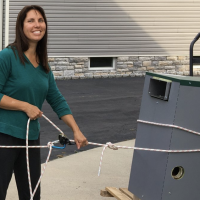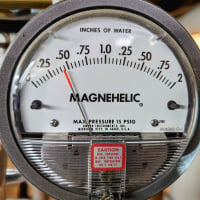How much is too much (makeup water)

One of the more common questions we get is how much makeup water is too much? Obviously for hydronic — hot water — systems, the answer is simple: any makeup at all, as they are closed systems and the only way water can leave is a leak.
So for an hydronic system, zero.
But for steam the question is slightly more complicated, so just for the sake of laughs I contemplated it a bit.
Where does a steam system lose makeup water? Well, almost all steam systems we encounter here on the wall are basically closed systems — but they also virtually all have vents so that sir can be released at the beginning of each cycle so that steam can get in. I have read a number of times that those vents release a lot of water, and that's where the makeup comes from.
Fair enough. How much water is that? So we need a few assumptions here. First, that the air in the pipes and radiators at the beginning of a cycle is at saturation with water vapour. Second, that all that air is purged during the cycle (true for most one pipe steam, not true for two pipe but let's not worry aobut that). Third, that the vent or vents close perfectly as soon as steam reaches them (good luck with that).
So where are we. Well, another assumption. Steam systems will vary in internal volume, but it iis not unreasonable to suppose that a moderate size steam system will have a total internal volume of around 200 cubic feet. That's the air we need to get rid of. And let's suppose that that air is sitting at around 70 F. At that temperature, the air at saturation with water vapour contains 0.001 pounds of water per cubic foot, so for our 200 cubic feet we have around 0.2 pounds of water vapour.
So for every cycle of the boiler we are going to lose around 0.2 pounds of water.or around 0.02 gallons (round numbers here, folks).
If we further suppose 10 cycles per day and 7 days in a week, that works out to around 2 gallons per week.
Which, honestly, is rather more than I had thought — but is an upper limit. Factors which can reduce that include that the air in the system isn't saturated with water vapour — which is significant — or that the air is cooler (just dropping the pipe temperature to 50 — a typical basement — cuts it in half) — or that not all the air is expelled on every cycle (so that a vapour steam system in good shape might cut it in half again).
On the other hand, any more than that has to be going somewhere it shouldn't — such as leaky vents or other leaks.
Comments?
Building superintendent/caretaker, 7200 sq. ft. historic house museum with dependencies in New England
Comments
-
there are some wrongish statements in your post but basically if you’re losing more than a gallon per month, start looking for your leaks
NJ Steam Homeowner.
Free NJ and remote steam advice: https://heatinghelp.com/find-a-contractor/detail/new-jersey-steam-help/
See my sight glass boiler videos: https://bit.ly/3sZW1el0 -
I'd agree with that, @ethicalpaul — and the musings weren't meant to be exact. What I now need to do is figure out just where the assumptions were amiss, and why. So since you mention you know where that might be, comment specifically please?
On the personal experience note — Cedric, who powers a medium size vapour system, uses a whopping total of about 3 gallons per year, exclusive of blowdowns for the LWCO. So I'd like to know why he doesn't use more…
Br. Jamie, osb
Building superintendent/caretaker, 7200 sq. ft. historic house museum with dependencies in New England1 -
2 pipe has a lot more opportunity to keep the water and the air being vented separated so it is likely to lose less water to evaporation.
The size of the system is going to have something to do wit the absolute amount of water that is lost. If you are venting 500' of pipe there will be more water vapor that comes with that air then 25'. If you have 50 vents there will be more steam that escapes as they are closing than with 6.
0 -
In a hot water system it would be common and not be a big deal for small amounts of water to seep out in a few places, especially packings.
0 -
the air that comes in at the end of a cycle doesn't have 0 water vapor in it. the basement is rarely 70. not all the air vents out in most systems, the vents are not usually where it turns in to a wet return, there is some main and drip and other pipes that can't vent and stay more or less full of air. that is why drips don't bang.
1 -
The question most people want answered is "how much added water will harm my boiler?"
And the answer is dependent on the water quality and the casting weight and iron quality of the appliance.
We've seen ancient boilers carry on for a dozen decade with loads of fresh make up water and we've seen Burnham boilers rot out in six years in the same systems. And we've seen manufacturers limit make up water to ridiculously low "safe" amounts.1 -
-
If we further suppose 10 cycles per day and 7 days in a week, that works out to around 2 gallons per week.
First of all, I commend your analysis for a 1 pipe system. All the values seem quite appropriate. I do consider it a worst case for 10 cycle per day.
HOWEVER, a typical steam boiler, in the coldest environments, is going to run far more than 10 cycles per day. I have one that runs 32 cycles per day…………deliberately………….on a Tekmar 279. I want it to run every 45 minutes to keep the mains warm. It may only run for 7 minutes if the ambient is not too cold.
This boiler, by your numbers, is going to lose 6 gallons per week in the worst case………..and, since it is connected to old radiator valves…………that leak………….the 6 gallons might be conservative.
Since it has a water meter, my infrequent observations of it show that 4-5 gallons per week was typical of it.
Note that it has no wet returns and no obvious leaks.
1 -
I appreciate your write up about it!
I think the part about vents losing water is questionable. Some do of course! But maybe fewer than you think
lots of calls for heat the steam doesn’t get to the vent or fill the radiator so that could reduce the air volume expelled
And we've seen manufacturers limit make up water to ridiculously low "safe" amounts.
I haven’t noticed this. The numbers I see manufacturers state are quite high in my opinion
NJ Steam Homeowner.
Free NJ and remote steam advice: https://heatinghelp.com/find-a-contractor/detail/new-jersey-steam-help/
See my sight glass boiler videos: https://bit.ly/3sZW1el0 -
Most of the heating season my system runs 2 cycles per hour, so 48 cycles a day. That's fairly consistent though it could be a little more or less.
I've never really measured my makeup water but I was under the impression it was something like 16 ounces a week. During a very cold week it may be more.
I'm convinced 100% of the water lost is to the air being pulled into the system between cycles.
Single pipe 392sqft system with an EG-40 rated for 325sqft and it's silent and balanced at all times.
0 -
At that rate, @ChrisJ , I'd agree with you!
Br. Jamie, osb
Building superintendent/caretaker, 7200 sq. ft. historic house museum with dependencies in New England0 -
-
200 feet of 3" main would be about 10 ft^2
0 -
-
If I had manufactured those castings, I would write that too 🤣
But in seriousness, that guidance isn't bad. If you have more than that, you probably do have leaks.
NJ Steam Homeowner.
Free NJ and remote steam advice: https://heatinghelp.com/find-a-contractor/detail/new-jersey-steam-help/
See my sight glass boiler videos: https://bit.ly/3sZW1el1 -
-
A four section boiler is not a larger system, is it?
NJ Steam Homeowner.
Free NJ and remote steam advice: https://heatinghelp.com/find-a-contractor/detail/new-jersey-steam-help/
See my sight glass boiler videos: https://bit.ly/3sZW1el0 -
I'm picturing these circled.
Single pipe 392sqft system with an EG-40 rated for 325sqft and it's silent and balanced at all times.
0 -
-
-
Certainly larger boilers exist, but Ed's quote about one gallon per year that I was responding to was specifically referencing 4 section IN boilers.
NJ Steam Homeowner.
Free NJ and remote steam advice: https://heatinghelp.com/find-a-contractor/detail/new-jersey-steam-help/
See my sight glass boiler videos: https://bit.ly/3sZW1el0 -
I didn't realize they gave different amounts for larger ones?
Single pipe 392sqft system with an EG-40 rated for 325sqft and it's silent and balanced at all times.
0 -
I couldn’t find any statements regarding it. I am just responding to what Ed said
NJ Steam Homeowner.
Free NJ and remote steam advice: https://heatinghelp.com/find-a-contractor/detail/new-jersey-steam-help/
See my sight glass boiler videos: https://bit.ly/3sZW1el0 -
This is from Burnham's 2011 Independence manual. The new one may be the same, I don't know I just looked in what I had on hand.
Single pipe 392sqft system with an EG-40 rated for 325sqft and it's silent and balanced at all times.
0 -
I guess Burnham thinks there are 10 heating months per year? 😅
I do like what they say about oxygen, salt and other junk in the makeup water. It makes me feel even better about using distilled.
Because if anyone knows about rotted out boilers…do I need to finish this joke or did you see it coming?
NJ Steam Homeowner.
Free NJ and remote steam advice: https://heatinghelp.com/find-a-contractor/detail/new-jersey-steam-help/
See my sight glass boiler videos: https://bit.ly/3sZW1el0
Categories
- All Categories
- 87.3K THE MAIN WALL
- 3.2K A-C, Heat Pumps & Refrigeration
- 61 Biomass
- 429 Carbon Monoxide Awareness
- 120 Chimneys & Flues
- 2.1K Domestic Hot Water
- 5.8K Gas Heating
- 115 Geothermal
- 167 Indoor-Air Quality
- 3.7K Oil Heating
- 77 Pipe Deterioration
- 1K Plumbing
- 6.5K Radiant Heating
- 395 Solar
- 15.7K Strictly Steam
- 3.4K Thermostats and Controls
- 56 Water Quality
- 51 Industry Classes
- 50 Job Opportunities
- 18 Recall Announcements





